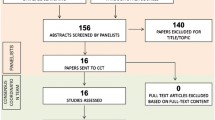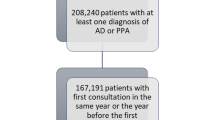Abstract
Primary progressive aphasia (PPA) is considered a heterogeneous syndrome, with different clinical subtypes and neuropathological causes. Novel PET biomarkers may help to predict the underlying neuropathology, but many aspects remain unclear. We studied the relationship between amyloid PET and PPA variant in a clinical series of PPA patients. A systematic review of the literature was performed. Patients with PPA were assessed over a 2-year period and classified based on language testing and the International Consensus Criteria as non-fluent/agrammatic (nfvPPA), semantic (svPPA), logopenic variant (lvPPA) or as unclassifiable (ucPPA). All patients underwent a Florbetapir (18-F) PET scan and images were analysed by two nuclear medicine physicians, using a previously validated reading method. Relevant studies published between January 2004 and January 2016 were identified by searching Medline and Web of Science databases. Twenty-four PPA patients were included (13 women, mean age 68.8, SD 8.3 years; range 54–83). Overall, 13/24 were amyloid positive: 0/2 (0%) nfvPPA, 0/4 (0%) svPPA, 10/14 (71.4%) lvPPA and 3/4 (75%) ucPPA (p = 0.028). The systematic review identified seven relevant studies, six including all PPA variants and one only lvPPA. Pooling all studies together, amyloid PET positivity was 122/224 (54.5%) for PPA, 14/52 (26.9%) for nfvPPA, 6/47 (12.8%) for svPPA, 101/119 for lvPPA (84.9%) and 12/22 (54.5%) for ucPPA. Amyloid PET may help to identify the underlying neuropathology in PPA. It could be especially useful in ucPPA, because in these cases it is more difficult to predict pathology. ucPPA is frequently associated with amyloid pathology.


Similar content being viewed by others
References
Mesulam MM (1982) Slowly progressive aphasia without generalized dementia. Ann Neurol 11:592–598
Mesulam MM (2001) Primary progressive aphasia. Ann Neurol 49:425–432
Gorno-Tempini ML, Hillis AE, Weintraub S et al (2011) Classification of primary progressive aphasia and its variants. Neurology 76:1006–1014
Gorno-Tempini ML, Dronkers NF, Rankin KP et al (2004) Cognition and anatomy in three variants of primary progressive aphasia. Ann Neurol 55:335–346
Nestor PJ, Graham NL, Fryer TD, Williams GB, Patterson K, Hodges JR (2003) Progressive non-fluent aphasia is associated with hypometabolism centered on the left anterior insula. Brain 126:2406–2418
Mummery CJ, Patterson K, Price CJ, Ashburner J, Frackowiak RS, Hodges JR (2000) A voxel-based morphometry study of semantic dementia: relationship between temporal lobe atrophy and semantic memory. Ann Neurol 47:36–45
Josephs KA, Duffy JR, Strand EA, Whitwell JL, Layton KF, Parisi JE, Hauser MF, Witte RJ, Boeve BF, Knopman DS, Dickson DW, Jack CR Jr, Petersen RC (2006) Clinicopathological and imaging correlates of progressive aphasia and apraxia of speech. Brain 129:1385–1398
Knibb JA, Xuereb JH, Patterson K, Hodges JR (2006) Clinical and pathological characterization of progressive aphasia. Ann Neurol 59:156–165
Mesulam M, Wicklund A, Johnson N, Rogalski E, Léger GC, Rademaker A, Weintraub S, Bigio EH (2008) Alzheimer and frontotemporal pathology in subsets of primary progressive aphasia. Ann Neurol 63:709–719
Grossman M, Wood EM, Moore P, Neumann M, Kwong L, Forman MS, Clark CM, McCluskey LF, Miller BL, Lee VM, Trojanowski JQ (2007) TDP-43 pathologic lesions and clinical phenotype in frontotemporal lobar degeneration with ubiquitin-positive inclusions. Arch Neurol 64:1449–1454
Chare L, Hodges JR, Leyton CE, McGinley C, Tan RH, Kril JJ, Halliday GM (2014) New criteria for frontotemporal dementia syndromes: clinical and pathological diagnostic implications. J Neurol Neurosurg Psychiatry 85:866–871
McKhann GM, Knopman DS, Chertkow H et al (2011) The diagnosis of dementia due to Alzheimer’s disease: recommendations from the National Institute on Aging-Alzheimer’s Association workgroups on diagnostic guidelines for Alzheimer’s disease. Alzheimers Dement 7:263–269
Dubois B, Feldman HH, Jacova C et al (2014) Advancing research diagnostic criteria for Alzheimer’s disease: the IWG-2 criteria. Lancet Neurol 13:614–629
Rabinovici GD, Jagust WJ, Furst AJ, Ogar JM, Racine CA, Mormino EC, O’Neil JP, Lal RA, Dronkers NF, Miller BL, Gorno-Tempini ML (2008) Abeta amyloid and glucose metabolism in three variants of primary progressive aphasia. Ann Neurol 64:388–401
Leyton CE, Villemagne VL, Savage S, Pike KE, Ballard KJ, Piguet O, Burrell JR, Rowe CC, Hodges JR (2011) Subtypes of progressive aphasia: application of the International Consensus Criteria and validation using β-amyloid imaging. Brain 134:3030–3043
Ikeda M, Tashiro Y, Takai E et al (2014) CSF levels of Aβ1-38/Aβ1-40/Aβ1-42 and (11)C PiB-PET studies in three clinical variants of primary progressive aphasia and Alzheimer’s disease. Amyloid 21:238–245
Josephs KA, Duffy JR, Strand EA, Machulda MM, Senjem ML, Lowe VJ, Jack CR Jr, Whitwell JL (2014) APOE ε4 influences β-amyloid deposition in primary progressive aphasia and speech apraxia. Alzheimers Dement 10:630–636
Matías-Guiu JA, Cabrera-Martín MN, Moreno-Ramos T, Valles-Salgado M, Fernandez-Matarrubia M, Carreras JL, Matías-Guiu J (2015) Amyloid and FDG-PET study of logopenic primary progressive aphasia: evidence for the existence of two subtypes. J Neurol 262:1463–1472
Martersteck A, Murphy C, Rademaker A, Wieneke C, Weintraub S, Chen K, Mesulam MM, Rogalski E, Initiative Alzheimer’s Disease Neuroimaging (2016) Alzheimer’s disease neuroimaging initiative. Is in vivo amyloid distribution asymmetric in primary progressive aphasia? Ann Neurol 79:496–501
Clark CM, Pontecorvo MJ, Beach TG, for the AV-45-A16 Study Group et al (2012) Cerebral PET with Florbetapir compared with neuropathology at autopsy for detection of neuritic amyloid-β plaques: a prospective cohort study. Lancet Neurol 11:669–678
Moher D, Liberati A, Tetzlaff J, Altman DG, PRISMA Group (2009) Preferred reporting items for systematic reviews and meta-analyses: the PRISMA statement. PLoS Med 6(7):e1000097
Josephs KA, Duffy JR, Strand EA, Machulda MM, Vemuri P, Senjem ML, Perkerson RB, Baker MC, Lowe V, Jack CR Jr, Rademakers R, Whitwell JL (2014) Progranulin-associated PiB-negative logopenic primary progressive aphasia. J Neurol 261:604–614
Botha H, Duffy JR, Whitwell JL, Strand EA, Machulda MM, Schwarz CG, Reid RI, Spychalla AJ, Senjem ML, Jones DT, Lowe V, Jack CR, Josephs KA (2015) Classification and clinicoradiologic features of primary progressive aphasia (PPA) and apraxia of speech. Cortex 69:220–236
Whitwell JL, Duffy JR, Strand EA, Machulda MM, Senjem ML, Schwarz CG, Reid R, Baker MC, Perkerson RB, Lowe VJ, Rademakers R, Jack CR Jr, Josephs KA (2015) Clinical and neuroimaging biomarkers of amyloid-negative logopenic primary progressive aphasia. Brain Lang 142:45–53
Whitwell JL, Weigand SD, Duffy JR, Strand EA, Machulda MM, Senjem ML, Gunter JL, Lowe VJ, Jack CR Jr, Josephs KA (2016) Clinical and MRI models predicting amyloid deposition in progressive aphasia and apraxia of speech. Neuroimage Clin 11:90–98
Ballard KJ, Savage S, Leyton CE, Vogel AP, Hornberger M, Hodges JR (2014) Logopenic and nonfluent variants of primary progressive aphasia are differentiated by acoustic measures of speech production. PLoS One 9(2):e89864
Leyton CE, Hodges JR, McLean CA, Kril JJ, Piguet O, Ballard KJ (2015) Is the logopenic-variant of primary progressive aphasia a unitary disorder? Cortex 67:122–133
Lehmann M, Ghosh PM, Madison C, Laforce R Jr, Corbetta-Rastelli C, Weiner MW, Greicius MD, Seeley WW, Gorno-Tempini ML, Rosen HJ, Miller BL, Jagust WJ, Rabinovici GD (2013) Diverging patterns of amyloid deposition and hypometabolism in clinical variants of probable Alzheimer’s disease. Brain 136:844–858
Whitwell JL, Lowe VJ, Duffy JR, Strand EA, Machulda MM, Kantarci K, Wille SM, Senjem ML, Murphy MC, Gunter JL, Jr Jack CR, Josephs KA (2013) Elevated occipital β-amyloid deposition is associated with widespread cognitive impairment in logopenic progressive aphasia. J Neurol Neurosurg Psychiatry 84:1357–1364
Jung Y, Whitwell JL, Duffy JR, Strand EA, Machulda MM, Senjem ML, Lowe V, Jack CR Jr, Josephs KA (2014) Amyloid burden correlates with cognitive decline in Alzheimer’s disease presenting with aphasia. Eur J Neurol 21:1040–1043
Jung Y, Whitwell JL, Duffy JR, Strand EA, Machulda MM, Senjem ML, Jack CR, Lowe VJ, Josephs KA (2016) Regional β-amyloid burden does not correlate with cognitive or language deficits in Alzheimer’s disease presenting as aphasia. Eur J Neurol 23:313–319
Laforce R Jr, Tosun D, Ghosh P, Lehmann M, Madison CM, Weiner MW, Miller BL, Jagust WJ, Rabinovici GD (2014) Parallel ICA of FDG-PET and PiB-PET in three conditions with underlying Alzheimer’s pathology. Neuroimage Clin 4:508–516
Mendez MF, Sabodash V (2015) Clinical amyloid imaging in logopenic progressive aphasia. Alzheimer Dis Assoc Disord 29:94–96
Teichmann M, Kas A, Boutet C, Ferrieux S, Nogues M, Samri D, Rogan C, Dormont D, Dubois B, Migliaccio R (2013) Deciphering logopenic primary progressive aphasia: a clinical, imaging and biomarker investigation. Brain 136:3474–3488
Patricio CM, Gabriela C, Julieta RM et al (2015) Concordance between 11C-PIB-PET and clinical diagnosis in a memory clinic. Am J Alzheimers Dis Other Demen 30:599–606
Sajjadi SA, Patterson K, Arnold RJ, Watson PC, Nestor PJ (2012) Primary progressive aphasia: a tale of two syndromes and the rest. Neurology 78:1670–1677
Sajjadi SA, Patterson K, Nestor PJ (2014) Logopenic, mixed, or Alzheimer-related aphasia? Neurology 82:1127–1131
Harris JM, Gall C, Thompson JC, Richardson AM, Neary D, du Plessis D, Pal P, Mann DM, Snowden JS, Jones M (2013) Classification and pathology of primary progressive aphasia. Neurology 81:1832–1839
Hodges JR (2016) Pathological diagnosis during life in patients with primary progressive aphasia: seeking the holy grail. JAMA Neurol 73:788–789
Mesulam MM (2013) Primary progressive aphasia and the language network: the 2013 H. Houston Merritt Lecture. Neurology 81:456–462
Hodges JR, Mitchell J, Dawson K, Spillantini MG, Xuereb JH, McMonagle P, Nestor PJ, Patterson K (2010) Semantic dementia: demography, familial factors and survival in a consecutive series of 100 cases. Brain 133:300–306
Hu WT, McMillan C, Libon D, Leight S, Forman M, Lee VM, Trojanowski JQ, Grossman M (2010) Multimodal predictors for Alzheimer disease in nonfluent primary progressive aphasia. Neurology 75:595–602
Rohrer JD, Ridgway GR, Crutch SJ, Hailstone J, Goll JC, Clarkson MJ, Mead S, Beck J, Mummery C, Ourselin S, Warrington EK, Rossor MN, Warren JD (2010) Progressive logopenic/phonological aphasia: erosion of the language network. Neuroimage 49:984–993
Kas A, Uspenskaya O, Lamari F, de Souza LC, Habert MO, Dubois B, Teichmann M, Sarazin M (2012) Distinct brain perfusion pattern associated with CSF biomarkers profile in primary progressive aphasia. J Neurol Neurosurg Psychiatry 83:695–698
Gil-Navarro S, Lladó A, Rami L, Castellví M, Bosch B, Bargalló N, Lomeña F, Reñé R, Montagut N, Antonell A, Molinuevo JL, Sánchez-Valle R (2013) Neuroimaging and biochemical markers in the three variants of primary progressive aphasia. Dement Geriatr Cogn Disord 35:106–117
Santangelo R, Coppi E, Ferrari L, Bernasconi MP, Pinto P, Passerini G, Comi G, Magnani G (2015) Cerebrospinal fluid biomarkers can play a pivotal role in the diagnostic work up of primary progressive aphasia. J Alzheimers Dis 43:1429–1440
Jansen WJ, Ossenkoppele R, Knol DL et al (2015) Prevalence of cerebral amyloid pathology in persons without dementia: a meta-analysis. JAMA 313:1924–1938
Ossenkoppele R, Jansen WJ, Rabinovici G et al (2015) Prevalence of amyloid PET positivity in dementia syndromes. A Meta-analysis. JAMA 313:1939–1949
Gefen T, Gasho K, Rademaker A, Lalehzari M, Weintraub S, Rogalski E, Wieneke C, Bigio E, Geula C, Mesulam MM (2012) Clinically concordant variations of Alzheimer pathology in aphasic versus amnestic dementia. Brain 135:1554–1565
Mesulam MM, Weintraub S, Rogalski EJ, Wieneke C, Geula C, Bigio EH (2014) Asymmetry and heterogeneity of Alzheimer’s and frontotemporal pathology in primary progressive aphasia. Brain 137:1176–1192
Ossenkoppele R, Schonhaut DR, Schöll M et al (2016) Tau PET patterns mirror clinical and neuroanatomical variability in Alzheimer’s disease. Brain 139:1551–1567
Author information
Authors and Affiliations
Corresponding author
Ethics declarations
Conflicts of interest
The authors declare that they have no conflict of interest.
Ethical standard
The Ethics Committee for medical research of Hospital Universitario Doce de Octubre has approved this study.
Funding
Drs. Llamas-Velasco (CM13/00079) and González-Sánchez (CM15/00222) have been supported by a Rio Hortega grant for clinical research (Instituto de Salud Carlos III, Spain).
Rights and permissions
About this article
Cite this article
Villarejo-Galende, A., Llamas-Velasco, S., Gómez-Grande, A. et al. Amyloid pet in primary progressive aphasia: case series and systematic review of the literature. J Neurol 264, 121–130 (2017). https://doi.org/10.1007/s00415-016-8324-8
Received:
Revised:
Accepted:
Published:
Issue Date:
DOI: https://doi.org/10.1007/s00415-016-8324-8




